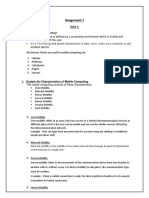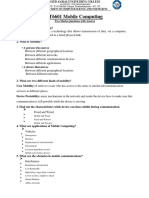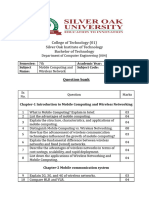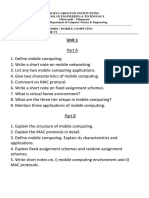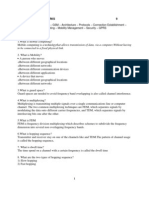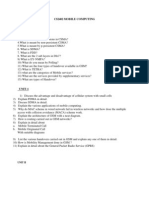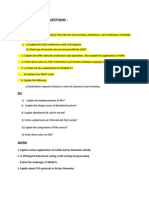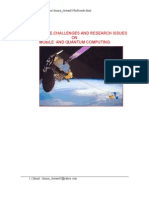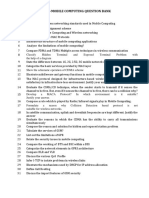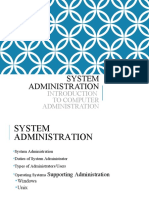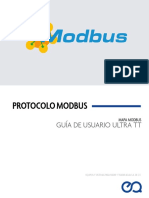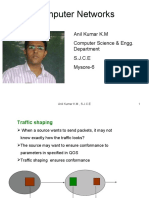Wireless Network and Mobile Computing
Question Bank
MODULE 1
1. Explain the 3-tier architecture in mobile computing. What are the advantages of using
this architecture in mobile applications?
2. What are the main design considerations for mobile computing? Discuss how each
impacts mobile application performance and user experience.
3. Describe the role and applications of Wireless Broadband, specifically WiMAX, in
mobile computing.
4. What is Mobile IP? Describe its role in enabling mobility in mobile devices.
5. Explain the process of discovery, registration, and tunnelling in Mobile IP.
6. Discuss how Cellular IP differs from traditional IP in supporting mobile devices.
7. Describe how Mobile IP functions with IPv6 and compare it to Mobile IP with IPv4.
8. Outline the architecture of GSM and describe the main entities involved.
9. How does call routing work in GSM? Explain the steps from caller to receiver.
10. What is the role of the PLMN Interface in GSM, and why is it essential for mobile
communication?
11. Discuss the structure and function of GSM addresses and identities. How are they
used in network aspects of GSM?
12. Explain the concept of Mobility Management in GSM and its importance for
maintaining communication.
13. What is SMS? Describe its architecture and how it functions as an information bearer
in mobile networks.
14. Differentiate between Short Message Mobile-Terminated (SMMT) and Short
Message Mobile-Originated (SMMO) messages.
15. Describe the architecture of GPRS, its network operations, and its role in packet data
services for mobile communication.
16. List out the major categories of middle ware in applications
17. Explain the following GSM entities: i) BSS il NS ii) NSS
18. List and explain the different parameters used in GPRS QoS profiles.
19. Explain with neat block diagram architecture of SMS (Short Message Service).
20. Explain CDMA data protocol stack format
�Module-2
1. Explain with neat block diagram architecture of mobile IP with their capabilities.
2. Explain with neat block diagram the components of PDA.
3. Write a short note on cellular IP
4. Write and explain structure of a mobile device.
5. Bring out the difference between mobile phones, PDA and communicators.
6. Explain how Spread Spectrum technology works and discuss its importance in
wireless communication.
7. Describe the IS-95 standard, including its development, features, and applications in
mobile communication.
8. Compare and contrast CDMA and GSM technologies in terms of architecture,
efficiency, and usage scenarios.
9. What are the primary challenges and solutions associated with wireless data
transmission?
10. Outline the key improvements and innovations introduced by 3G networks over
previous generations.
11. List and describe various applications made possible by 3G networks and their impact
on industries and consumers.
12. How has mobile client technology evolved to support a broader range of applications
beyond traditional desktop use?
13. Provide an overview of mobile handset architecture and the role of each key
component in supporting mobile applications.
14. Discuss the essential features of modern mobile phones that make them effective tools
for both communication and productivity.
15. What is a PDA, and how has it influenced the development of mobile devices and
applications?
16. What are the major design constraints developers face when creating applications for
handheld devices?
17. How does power management in mobile devices impact application design and user
experience?
18. What are the critical factors to consider when designing user interfaces for small
screens on mobile devices?
19. Explain common security concerns associated with mobile applications and how they
can be addressed in design.
20. What are some emerging trends in mobile technology, and how might they shape the
future of mobile application development?











